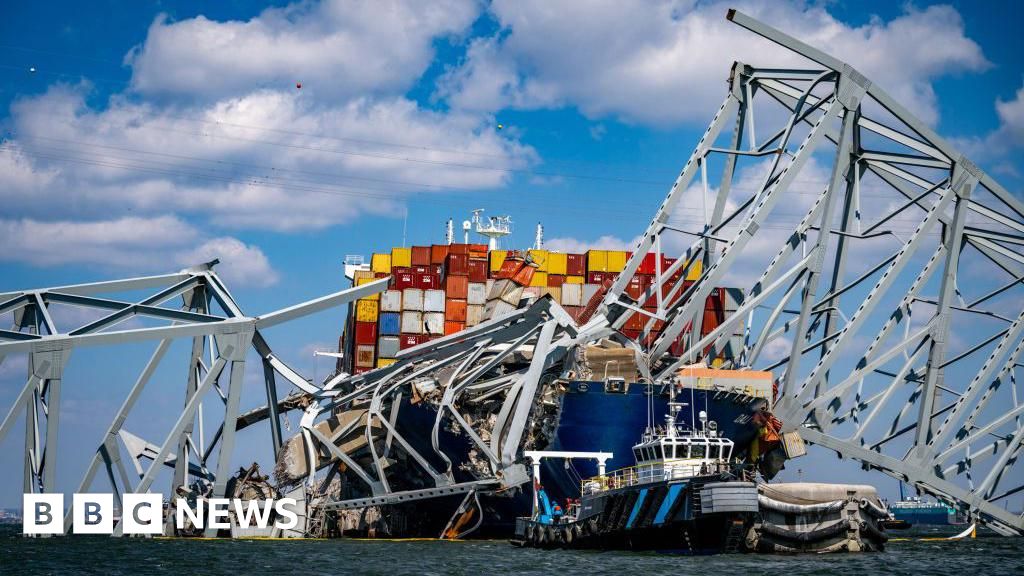 Getty Images
Getty ImagesIn the dark, early morning hours of 26 March, US transportation secretary Pete Buttigieg’s phone rang – and he immediately knew he had a problem.
“If my phone rings in the middle of the night, it’s not a good thing,” he recalled.
The Dali, a massive 948ft (289m) cargo ship had slammed into Baltimore’s iconic Francis Scott Key Bridge, sending the 1.5-mile (2.4km) bridge into the cold waters of the state’s Patapsco River.
“It wasn’t immediately clear what we were dealing with,” Buttigieg told the BBC in an interview. “How many people had been impacted, and how much of the bridge had been destroyed.”
Six men, all members of a road crew working on the bridge, were killed in the incident, which left the Dali – still afloat – stuck under huge chunks of shredded metal and concrete. Another man was pulled from the icy water, seriously injured.
A new documentary from BBC One – available on iPlayer on 5 December – reveals new details of the investigation into the crash, including a possible cause: a cable that shook loose, disrupting the ship’s power supply and causing an initial blackout minutes before it struck the bridge.
After that, investigators believe they discovered a lack of fuel pressure to the generators may have created power fluctuations that tripped breakers and caused the ship to go dark again, with no time to change course before slamming into the bridge.
Previously unseen bodycam footage taken after the collapse shows first responders and officials struggling to come to grips with the enormity of what they faced in the confusing hours after the crash.
“Key Bridge is down. It was last reported that there are at least several vehicles in the water,” an officer can be heard saying. “And several people still unaccounted for.”

‘A hell of a clean-up’
In the aftermath of the collapse, an estimated 3,000 to 4,000 tonnes of debris blocked the Patapsco, a 700ft (213m) wide and 50ft (15m) deep and economically vital shipping channel.
Recovering the bodies and removing the twisted, broken steel and concrete from the channel – plus moving the Dali – fell to a massive team including US Army, Navy and Coast Guard members, as well as Maryland authorities and specialist private firms.
The woman who led the effort, Colonel Estee Pinchasin, the Army Corps of Engineers Baltimore district commander, said that she had “never seen anything of that magnitude before”.
“Everything [was] mangled up on top and around,” she said. “You had these big, large spans that were just laying in the water. You see four-inch steel that’s been bent… how can you even start to think about the force?”
The dangerous work of searching the debris field and determining which pieces could be safely removed – and when – fell, in part, to teams of divers who inspected both the ship and the destruction beneath the surface.
Never-before-seen footage obtained by the BBC shows the difficult conditions they faced: jagged and potentially dangerous pieces of rubble and muddy, brown water, which often meant they could not see more than a foot or two ahead of them.
“There was no visibility. I kind of compared it to a metal jungle gym underwater,” recalled Robyn Bianchi, the assistant salvage master for one of the firms involved, Donjon Marine.
“You turn off all the lights in the room and try tell me all the pieces of where they connect to that metal jungle gym. Oh, and by the way, the jungle gym is completely twisted and looks nothing like it did when it was built to perfection.”
 Getty Images
Getty ImagesWhat caused the crash?
A preliminary report from the National Transportation Safety Board, or NTSB, found that two electrical blackouts disabled equipment ahead of the incident, and noted that the ship lost power twice in the 10 hours leading up to the crash.
In the aftermath, NTSB investigators were tasked with determining what happened. Eventually, they discovered a loose cable, which it is believed may have caused a power surge that tripped two breakers and disrupted electricity.
As the crew struggled to restart the engine, a second blackout took place, likely as the result of a pump supplying generators with fuel shutting down and not restarting automatically.
The erratic generators may have created additional power fluctuations that trip the ship’s breakers – a common occurrence faced by seafarers, but which mostly takes place in open waters.
Sal Mercogliano, a maritime historian and former merchant mariner, said that the silence the sailors must have heard in those moments is “the worst sound you ever hear” on a ship.
“At that moment, you realise you don’t have control of the ship anymore,” he added. “It is a nightmare… you have a very short period of time in which to restore power.”
In the Dali’s case, it was already too late. The time between the ship losing power and striking the bridge, it was later determined, was about four minutes.
Despite the destruction and loss of life, officials are relieved that the incident was not worse.
On the night of the collapse, police were able to stop traffic, with the last car clearing the bridge just 40 seconds before it fell.
“Cars would have kept coming,” Maryland Governor Wes Moore said. “By the time the people driving the vehicles realised the bridge was gone, it just would have been too late.”
“I can’t tell you how many lives they saved,” he added. “Because the answer is countless.”


Leave a Reply